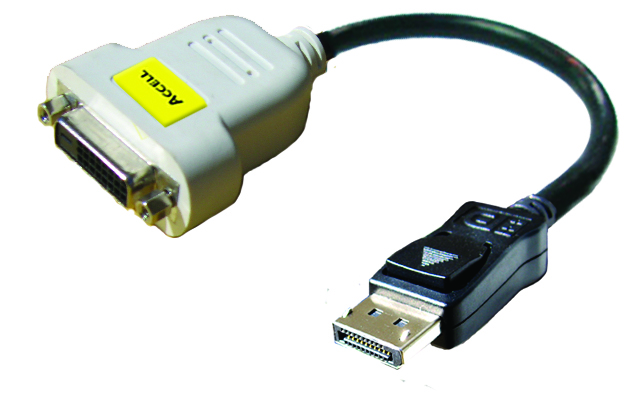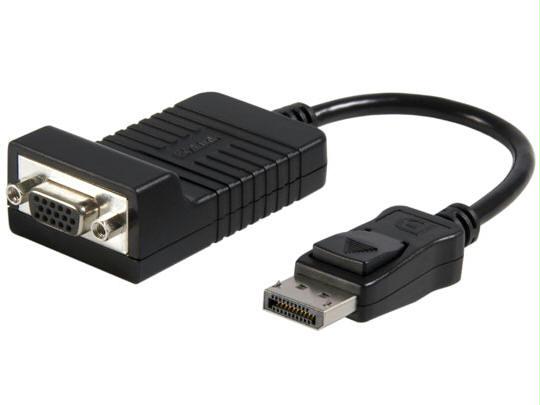Part 2: AMD's Eyefinity Technology Explained
General Dongle Education
As we mentioned in the prior Eyefinity story, there are two kinds of dongles for Eyefinity: passive and active. As with any other kind of dongle for your PC, these adapters convert one type of connection into another. Conventional video port types are based on Transition Minimized Differential Signaling (TMDS) and use either DVI or HDMI interfaces. TMDS is substantially different than DisplayPort. For example, TMDS uses raster scanning, whereas DisplayPort is packetized. The protocols are different. TMDS typically runs at about 5V while DisplayPort is only 3.3V.
Passive dongles drive non-DisplayPort signals through the DisplayPort connectors by shifting signals from one format to the other. (This is why you might sometimes hear dongles referred to as level shifters.) The graphics card is able to sense that a passive dongle is attached to the DP connector. At that point, instead of passing a 3.3V DisplayPort stream, the card outputs a 3.3V TMDS signal through that port and the passive dongle shifts the voltage level up to meet the TMDS spec.
Active dongles are composed of a DisplayPort receiver, which attaches to the graphics card, and a TMDS transmitter, which integrates a digital-to-analog converter (DAC) for VGA output. That’s really the main difference between the two types. Power is often supplied by a cable that connects to a USB port. With an active dongle, the adapter looks like a DisplayPort to the graphics card, so the card transmits DisplayPort signals natively. In the passive case, the card outputs TMDS for HDMI or DVI displays.
Is Your Dongle Flashing?
The critical thing to know about Eyefinity and dongles is that there’s a hard limit of two TMDS output streams, period. So, if you want to use Eyefinity to set up a 2x1 “array” (yes, dual-monitor Eyefinity sounds a bit silly, but that’s how the driver sees it), it doesn’t matter what you throw at the card. Two VGA screens? No problem. You could use a VGA adapter on a DVI port and an active VGA dongle on a DisplayPort connection. Just keep your legacy output stream count in mind as you scale beyond two monitors.
“If you’re already using two DVI connectors on the board, you can’t use a passive dongle because, in theory, that would be a third TMDS signal stream,” says Roger Quero, technical manager at AMD’s GPU Technologies unit. “You can have two passive dongles, and the rest have to be active. Like, if you’re thinking about the six-output card, that’s six mini DisplayPorts. Two of those connections could be passive, putting out TMDS over those ports, then the rest have to be active so that we think it’s a DisplayPort monitor.”
There’s a catch with active adapters, though. A lot of early buzz flew around Web forums, noting that some active dongle-attached displays were “blinking.” There are only a handful of potential causes for this. One is that you’ve simply got a dud dongle. A more common cause is that the dongle isn’t getting enough power through the USB connection, specifically 5V at 500mA. This could be the result of improper wiring, bad power management, a low-power USB setting in the BIOS, not having external power to a USB hub, and similar factors. The easy test is to switch to a known high power USB port or powered hub. If that fixes the problem, you have your culprit.
Get Tom's Hardware's best news and in-depth reviews, straight to your inbox.
The third possible cause pertains to dongle quality. As with so many other components in the PC space, there are reputable brands that pride themselves on quality and no-name brands that only seek to sell high volumes at rock bottom prices, regardless of whether the product works as it should or not.
“With inferior dongles,” says AMD’s Roger Quero, “you could end up with your panels flashing or flickering. It might appear to be working fine, but then you can’t set up an Eyefinity large surface. You could run into problems with EMI emissions. Some are not FCC-certified. It comes down to if you’re buying from a reputable vendor versus from Bob’s Dongles and Tackle Shop.”
“This is why we operate a dongle validation program, frankly, to help separate the wheat from the chaff,” adds Bruce Gasson, AMD senior technical marketing specialist. “There are a lot of dongles out there and more arriving every day. Some do not work. That’s a fact. That’s one of the reasons for launching this program in the first place. We want to make sure that the dongles we promote are the ones that work.”
You can see the lengthening list of approved dongles here.
Currently, you’ll find active adapters available in the market for DisplayPort to VGA and DisplayPort to Dual-Link DVI. You’ll also find passive dongles for DisplayPort to HDMI and DisplayPort to Single-Link DVI. Keep watching, though, and you should soon see a DisplayPort to Single-Link DVI active dongle appear. With this, Eyefinity will be able to support three Single-Link DVI monitors, side-stepping the present two-TDMS-connections-only rule.
Current page: General Dongle Education
Prev Page It Starts With the Card Next Page Dangling Issues About Dongles-
akula2 I use 3 LCDs with 5770 as well as 5850 cards to run many applications simultaneously. Eyefinity feature offers so much and one could easily avoid buying additional PCs by tapping the features from the processor and the graphics card.Reply -
ckim2116 It'd be nice if AMD had their own list of Eyefinity supported games. Some of the games on WGF don't work; in fact, the only games that have worked out perfectly for me have been TF2, Batman Arkham Asylum, Torchlight, and L4D2 (all you have to do is select your resolution in the options, in my case 5760x1080). In other games the menu screen just keeps blinking, and attempting to change the resolution just freezes the game.Reply
Can't wait until all the kinks are worked out! -
cangelini akula2Could someone tell me what happened to the "Print" feature on Tom?Reply
It's right above the comments section, to the right of "Share," amongst a ton of tiny little icons :) -
jsowoc I don't see DisplayPort costing that much more. If I look at 22-24" LCDs, the cheapest they come is around $200 for a TN panel or $300 for a PVA monitor, and about $450-500 for an IPS monitor. It's personal preference whether the quality difference is worth the cost.Reply
If you compare a $200 TN w/out DisplayPort to a $500 IPS w/ DisplayPort, you are comparing apples to oranges. The Amazon price of $220 for a TN w/ DisplayPort is more representative of pricing. -
xrodney I am using 30" dell but only way i can use its native resolution is over DVI, on either HDMI or Displayport maximum of 1920x1200 is possible.Reply
I am not sure if this is limit on DELL only, but as far as I read neither ati 4xxx or 5xxx grapahic card and neither any widely available LCD supports more then that which is quite pitty.
Even more disapointing is that DHCP working only over single DVI link (1920x1200 max) on DELLs and probably others as well. -
1898 Very interesting read, thanks.Reply
ckim2116
From the article: http://support.amd.com/us/eyefinity/Pages/eyefinity-software.aspx -
RazberyBandit Hmm. Landscape-landscape-landscape seems like it would just be sick for gaming. ASUS monitor bezels are actually angled at the top and bottom. When stacked tightly in such an arrangement, they actually wrap around the viewer nicely. Three 24" 16:9 ratio (1920x1080) monitors stacked sideways yields a HUGE 3:2 ratio (3240x1920 resolution) display. Three 16:10 (1920x1200) monitors end up at 3600x1920. I like this idea better than the far more panoramic view of 5760x1080 or 5760x1200 for most games.Reply
Alas, I'll be waiting on the next-gen cards and monitors in hopes that prices drop and availability increases. I'd also like to see the proposed standards mentioned within this article actually go into effect, as well as see adoption of display port grow and the technology itself mature.
Lastly I hope stands adopt a standard that supports landscape-landscape-landscape, portrait-portrait-portrait, and any combination in-between. Having to go out and buy 3 cheap VESA mounts, some metal tubing and round-bar, then get to cutting, bending, and welding my own stand together sounds like a fun project, but I'd rather just buy a mass-produced one.
Edit: I meant portrait-portrait-portrait... -
gaborbarla Bought a 5870 HD the other day.Reply
Two questions remain for me that I couldnt filter out from these articles by skimming through them:
1. Why do we need a display port again? I thought the whole point of HDMI was to introduce a digital standard that works with everything TVs Digital signal processors, PCs. Now that most monitors, graphics cards and even some motherboards are starting to support HDMI they come out with a new format... (dot dot dot)
2. Why does the 5800 series need a display port? why couldn't it have 3 DVI-Ds? So far I haven't even seen a single monitor that has displayport.


